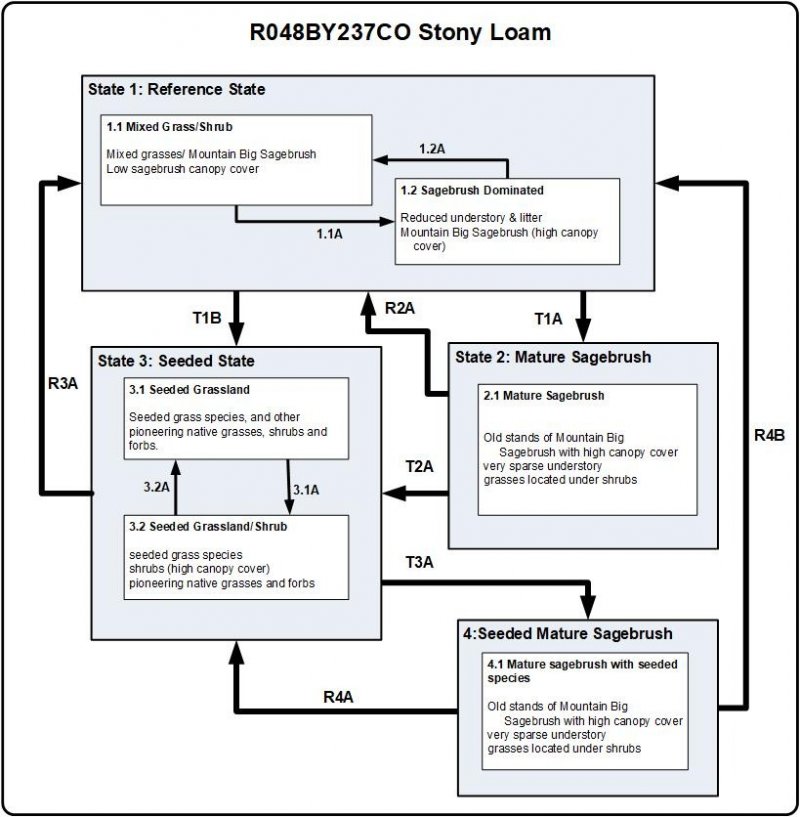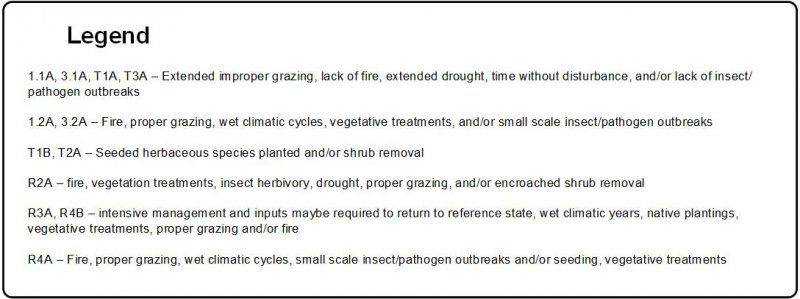
Natural Resources
Conservation Service
Ecological site R048BY237CO
Stony Loam
Last updated: 4/09/2025
Accessed: 12/21/2025
General information
Provisional. A provisional ecological site description has undergone quality control and quality assurance review. It contains a working state and transition model and enough information to identify the ecological site.
MLRA notes
Major Land Resource Area (MLRA): 048B–Southern Rocky Mountain Parks and Valleys
This area is in Colorado (96 percent) and Wyoming (4 percent). It makes up about 2,325 square miles (6,020 square kilometers). The town of Walden, in the northern part of this MLRA, is in a wide valley locally known as North Park. The town of Kremmling is in a valley locally known as Middle Park. The town of Hartsel, in the center of the southern part of the MLRA, is in a broad intermontane basin locally known as South Park. The northern part is bordered by the Medicine Bow, Routt, and Arapaho National Forests, and the southern part is bordered by the San Isabel and Pike National Forests. The Arapaho National Wildlife Refuge is directly south of the town of Walden.
This area is within the Southern Rocky Mountains Province of the Rocky Mountain System. It consists of nearly level to rolling mountain parks and valleys and a few narrow mountain ridges. It occurs as two separate parts in the center of the Southern Rockies. The southern half of the northern part is on the west side of the Continental Divide, and the rest of the MLRA is on the east side of the divide. Elevation ranges from 7,850 to 10,850 feet (2,395 to 3,310 meters). The head waters of North Platte River leaves Colorado and enters Wyoming in the northern half of the northern part of the MLRA (North Park). The headwaters of Colorado River is in the southern half of the northern part of the MLRA (Middle Park). The headwaters of South Platte River is in the southern part of the MLRA (South Park).
The mountain valleys and parks that are characteristic of this MLRA are surrounded by high mountain peaks of the adjacent Southern Rocky Mountains MLRA (48A). Steep slopes give rise to steep-gradient streams that can move cobbles and gravel from the mountain slopes down into the valleys. The coarse textured sediments on the surface of this area were deposited by either glacial meltwater or present-day rivers. Buried deep beneath the sediments is a complex of sedimentary and igneous rocks. Residuum from sedimentary rocks is on the steeper slopes that were not covered by alluvium and glacial outwash.
The average annual precipitation is mainly 10 to 16 inches (255 to 405 millimeters), but it is as high as 28 inches (710 millimeters) at the higher elevations that border the Southern Rocky Mountains MLRA. Precipitation generally increases with elevation. Rainfall occurs as high-intensity, convective thunderstorms during the growing season. About half of the annual precipitation falls as snow. Soil moisture is unevenly distributed within short distances because of snowdrifts. The amount of precipitation is highly influenced by rain shadows. The surrounding peaks receive most of the precipitation as storm systems traverse the area. The average annual temperature is 35 to 42 degrees F (1 to 6 degrees C). The freeze-free period averages 95 days and ranges from 70 to 120 days, decreasing in length with elevation.
The dominant soil order in this MLRA is Mollisols. Alfisols are of lesser extent. The soils are very shallow to deep, generally well drained, and loamy or clayey and have mixed or smectitic mineralogy. The soil temperature regime is dominantly cryic, but it is frigid in some small areas, primarily on south- or west-facing slopes. The soil moisture regime is mainly ustic, but a marginal aridic regime has been identified in areas where the average annual precipitation is less than about 12 inches (305 millimeters). The most extensive great group is Argicryolls (Hodden, Lucky, Parlin, Tiagos, and Cabin series), which commonly formed in outwash and slope alluvium on outwash terraces, fan remnants, hills, and mountain slopes. Haplocryolls (Redcloud and Tealson series) formed in outwash and slope alluvium on outwash terraces, valley side slopes, hills, and ridges. Haplocryalfs (Gebson and Harsha series) formed in slope alluvium and outwash on outwash terraces, fan remnants, hills, ridges, and mountain slopes. Cryaquolls (Dobrow and Randman series) formed in alluvium on stream terraces and flood plains.
Classification relationships
NRCS:
Major Land Resource Area 48B, Southern Rocky Mountain Parks (United States Department of Agriculture, Natural Resources Conservation Service, 2006).
USFS:
M331I – North Parks and Ranges Section Southern Rocky Mountain Steppe - Open Woodland - Coniferous Forest - Alpine Meadow
EPA:
21i – Sagebrush Parks and 21j – Grassland Parks < 21 Southern Rockies < 6.2 Western Cordillera < 6 Northwestern Forested Mountains North American Deserts (Griffith, 2006).
USGS: Southern Rocky Mountain Province
Ecological site concept
R048BY237CO Stony Loam occurs on mountain-slopes, ridges, fans and moraines. Slopes is between 20 to 70 percent. Soils are deep to very deep (40 inches or greater) with significant rock within the profile. Soils are derived from till; colluvium from igneous and metamorphic rock; or residuum from igneous and metamorphic rock. Soil surface texture is usually stony loam, cobbly loam, extremely stony sandy loam, gravelly sandy loam, very gravelly sandy loam, or very cobbly sandy loam with loamy-skeletal textured subsurface. It is a bluebunch wheatgrass – needlegrass community with mountain big sagebrush and serviceberry as a shrub component. It has a typic ustic moisture regime. The effective precipitation ranges from 16 to 20 inches.
Associated sites
| R048BY241CO |
Mountain Meadow R048BY241CO Mountain Meadow occurs on flood plains, stream terraces, drainageways and alluvial flats. Slopes is between 0 to 5%. Soils are moderately deep to very deep (25 to 100 inches). Soils are derived from alluvium from igneous and metamorphic rock. Soil surface texture is usually loam, fine sandy loam, silty clay loam or sandy clay loam with fine-loamy, fine-loamy over sandy-skeletal or coarse-loamy textured subsurface. It is a tufted hairgrass – Nebraska sedge community. |
|---|---|
| R048BY222CO |
Loamy Park R048BY222CO Loamy Park occurs on flood plains, flood-plain steps, hills, fans and stream terrace. Slopes is between 0 to 15%. Soils are very deep (60+ inches). Soils are derived from alluvium or colluvium. Soil surface texture is usually loam or sandy loam with fine-loamy textured subsurface. It is an Arizona fescue – mountain muhly community. |
| R048AA228CO |
Mountain Loam Gunnison Basin LRU R048AY228CO Mountain Loam occurs mainly alluvial fans, mountain slopes, benches, terraces, or hills. Slopes average between 5 and 10% but can range from 0 to 30%. Soils are moderately deep to deep (20-60 inches) loamy soils derived from residuum from igneous and metamorphic rocks or sandstone and shale; slope alluvium from sandstone and shale, or igneous and metamorphic rocks; colluvium from igneous and metamorphic rocks or sandstone and shale, and/or alluvium from igneous and metamorphic rocks. Soil surface texture are loam, sandy loam or silt loam with loamy subsurface. It is a mountain big sagebrush -Arizona fescue community. |
| R048AY240CO |
Shallow Pine R048AY240CO Shallow Pine occurs on mountains and mountainsides. Slopes are 5 to 50%. Soils are shallow (10 to 20 inches). Soils are derived from slope alluvium from volcanic breccia, gneiss, granite, or sandstone and/or residuum from granite, granodiorite and/or gneiss. Soil surface texture is a gravelly to very gravelly sandy loam or very gravelly loam with loamy-skeletal subsurface. It is a ponderosa pine - Arizona fescue – mountain muhly community. |
| R048BY296CO |
Claypan R048BY296CO Claypan occurs on hills, ridges, alluvial fans and terraces. Slopes is between 0 to 15%. Soils are moderately deep to deep (20 to 60 inches). Soils are derived from alluvium from sedimentary rock; colluvium from sandstone and shale; residuum from shale; or slope alluvium from sandstone and shale. Soil surface texture is usually loam or clay with fine textured subsurface. It is a little (low) sagebrush – western wheatgrass – pine needlegrass community. It has an aridic ustic moisture regime. The effective precipitation ranges from 12 to 16 inches. |
Similar sites
| R048AY237CO |
Stony Loam R048AY237CO Stony Loam occurs mainly alluvial fans, mountain slopes mountains and valley sides. Slopes is between 0 to 30%. Soils are deep (60 inches or more) loamy soils derived from outwash; till; colluvium from basalt, sandstone or granite and gneiss; and/or alluvium from igneous and metamorphic rocks; or basalt. Soil surface texture are stony to extremely stony loam, cobbly loam; or cobbly to very cobbly sandy loam with loamy-skeletal subsurface. It is a mountain big sagebrush - bluebunch wheatgrass community. |
|---|---|
| R048AY311CO |
Mountain Outwash R048AY311CO Mountain Outwash occurs on fan terraces, alluvial fans, and glacial moraines. Slopes are between 3 to 45%. Soils are deep (60+ inches). Soils are derived from alluvium that is coarse-textured and stony or cobbly. Soil surface texture is gravelly sandy loam or cobbly sandy loam with sandy-skeletal textured subsurface. It is an Arizona fescue – mountain muhly community. |
| R048AY287CO |
Stony Foothills R048AY287CO Stony Foothills occurs on mountains, escarpments and hills. Slopes is between 3 to 30%. Soils are moderately deep to deep (20 to 60+ inches). Soils are derived from alluvium, residuum or colluvium from sandstone and shale or alluvium from basalt. Soil surface texture is gravelly, stony, or very stony sandy loam or very cobbly loam with loamy-skeletal textured subsurface. It is a Wyoming big sagebrush – western wheatgrass community. It has a aridic ustic moisture regime and frigid temperature regime. The effective precipitation ranges from 12 to 16 inches. |
| R048AY316CO |
Dry Mountain Outwash R048AY316CO Dry Mountain Outwash occurs on fan terraces and alluvial fans. Slopes is between 1 to 45%. Soils are deep (60+ inches). Soils are derived from alluvium or outwash. Soil surface texture is gravelly sandy loam with sandy-skeletal textured subsurface. It is a prairie Junegrass – pine needlegrass community. It has an aridic ustic moisture regime and frigid temperature regime. The effective precipitation ranges from 12 to 16 inches. |
| R048BY291CO |
Loamy Glacial Outwash R048BY291CO Loamy Glacial Outwash occurs on fans and terraces. Slopes is between 1 to 45%. Soils are moderately deep to deep (20 to 60 inches). Soils are derived from outwash. Soil surface texture is usually very cobbly sandy loam, extremely cobbly sandy loam, very gravelly sandy loam or gravelly loam with loamy-skeletal textured subsurface. It is a Gambel oak – Arizona fescue – muttongrass community. It has a typic ustic moisture regime. The effective precipitation ranges from 14 to 18 inches. |
| R048AY377CO |
Skeletal Loam R048BY377CO Skeletal Loam occurs on hills, mountains, mountainsides, fan terraces, pediments, outwash terrace and mesas. Slopes is between 5 to 55%. Soils are deep to very deep (40 to 60+ inches). Soils are derived from slope alluvium from conglomerate, sandstone, trachyte, or volcanic breccia; outwash; colluvium from volcanic rock, trachyte, or volcanic breccia or residuum from volcanic rock. Soil surface texture is usually very gravelly loam. gravelly loam, very cobbly loam or very gravelly sandy loam with loamy-skeletal or clayey skeletal textured subsurface. It is an Arizona fescue – Parry’s oatgrass community. It has an aridic ustic moisture regime. The effective precipitation ranges from 14 to 16 inches. |
Table 1. Dominant plant species
| Tree |
Not specified |
|---|---|
| Shrub |
(1) Amelanchier alnifolia |
| Herbaceous |
(1) Pseudoroegneria spicata |
Click on box and path labels to scroll to the respective text.

